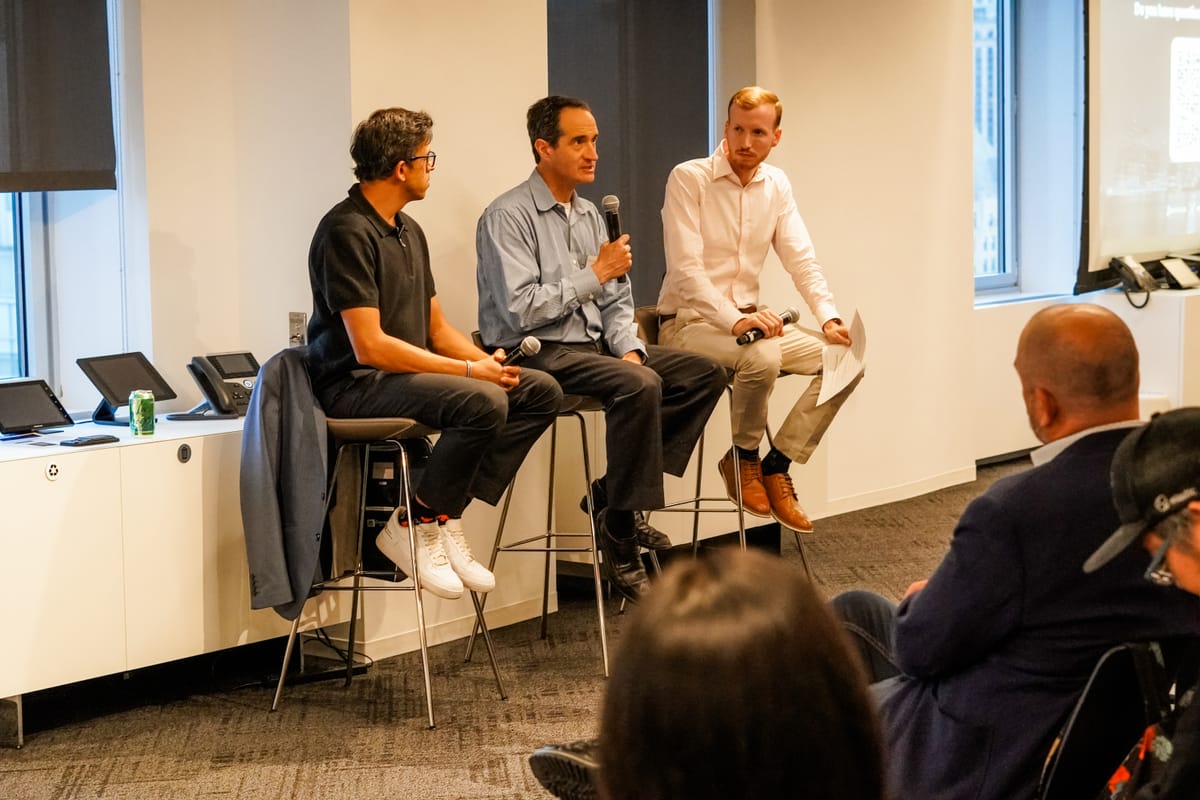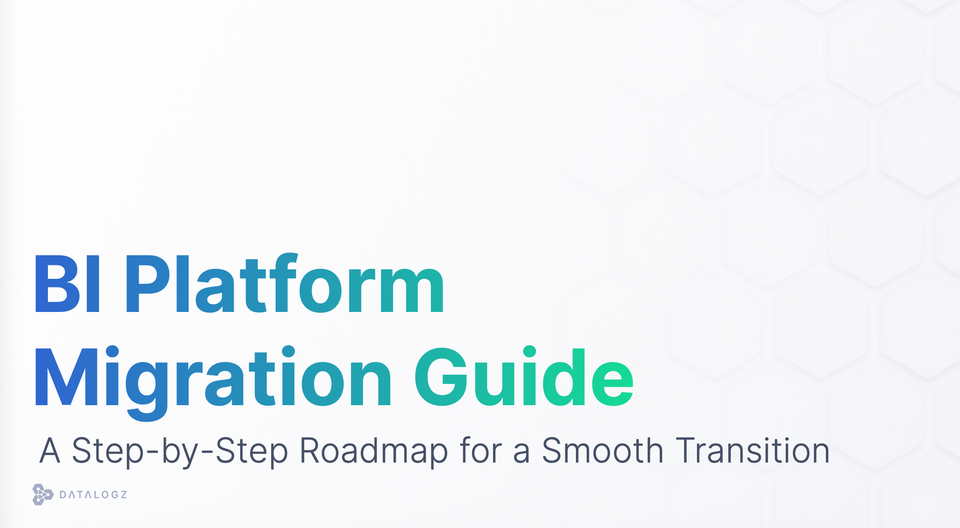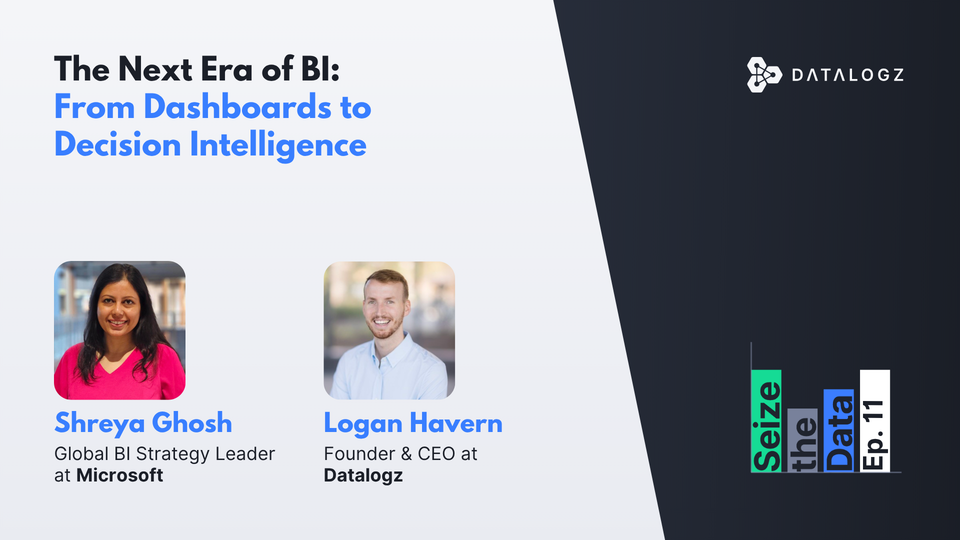Modernizing BI Governance Without Killing Self-Service
At the latest edition of Future Frontiers, data leaders came together for a wide-ranging discussion on AI, BI, and real-world stories of enterprises deploying solutions to improve governance and address BI Sprawl.

Inside Fortune 2000 enterprises, data and analytics leaders must strike a balance.
On one hand, they must encourage wide use of BI tools that harness data and insights to drive decision-making at scale.
At the same time, they must avoid the report duplication, governance blunders and security gaps that so often accompany self-service analytics, and lead to BI Sprawl.
This fine line is especially important to consider as generative AI joins the fold, and arms users with even more powerful capabilities to generate reports and dashboards.
At the latest edition of Future Frontiers, Datalogz and Metric Insights gathered leaders in data and analytics in New York City to do just that. At the panel discussion inside the Midtown Manhattan offices of Perkins Coie, Sid Raisoni, a next-gen CDO who has led analytics at Philip Morris, WWE, and Nestlé, joined Metric Insights CEO Marius Moscovici and Datalogz CEO Logan Havern for a wide-ranging discussion on AI, BI, and real-world stories of enterprises deploying solutions to improve governance and address BI Sprawl.
Here are a few highlights from the event:
The Governance Gap in Generative AI
Generative AI continues to garner unprecedented hype, yet there is increasing evidence that a gap is emerging between enterprises that are seeing true value from this powerful technology, and those who can’t get out of pilot mode.
The divide is stark.
A recent study from MIT NANDA showed that 95% of generative AI pilots are failing inside companies.
To be clear, that means only a tiny sliver of companies are seeing meaningful impact to the bottom line from generative AI.
The companies that are falling behind have access to models, teams ready to use them, and the executive support to fund pilots.
What they lack is governance at the point of integration.
Sid Raisoni has seen it inside global brands, across corporate America. Enterprises have hundreds of pilots that bring untold risk.
We’re not just talking about the risk of failure.
When new technology is tested, it lacks guardrails. That leaves companies exposed to all sorts of risk.
From cost to performance to security to processes, there are a host of risk factors that must be tested as part of any pilot.
If a pilot is to be successful, all of these elements must be tested, validated, and measured.
“With any new technology, the corporate world is essentially trying to build a new muscle. And that new muscle requires a lot of reflection, and understanding of, how do we leverage this technology to do better?” Raisoni said.
Technology has to work, but that’s just a first step. Pilots have to gauge the impact of technology on the company’s operations. They must determine how technology can scale throughout an organization. They must understand the risk presented.
And they must measure impact on the P&L.
Look closer at the 5% of companies that saw GenAI success, and you’ll find that they did all of those, and more. Most importantly, they’re building the muscles that will provide a competitive edge, now and going forward.
BI Sprawl: Kneecapping AI at the Starting Line
Generative AI is poised to revolutionize data and analytics, but enterprises who don’t act to root out BI Sprawl before implementation are doomed to repeat the mistakes of the past.
The most popular BI tools are all introducing AI capabilities, and improving them even as we write.
Tableau has Einstein. Power BI has CoPilot. It is easier than ever for business users to create reports and dashboards.
What used to take a day now takes a half-hour.
Think about all of the new reports and dashboards that are being created.
Today, most enterprise environments are already suffering under the weight of BI Sprawl, where duplicate, stale, and improperly-permissioned reports weigh down the effectiveness of data-driven decision-making.
With AI, there is even more of a mess. To make matters worse, AI is being trained on these reports.
It may be a new era, but the same rules of data engagement hold true:
Garbage in, garbage out.
Before letting AI loose, you have to clean up and prepare.
“At Datalogz, one of the biggest value props we've seen with customers over the last six months is going into BI systems, sorting through what's mess, what's duplicative, what is the CFO viewing versus what is a copy that doesn't matter, and helping sift through that noise to make it valuable,” said Logan Havern, CEO of Datalogz.
Once the environment is cleaned up, it sets the stage for automated analytics.
But you can’t skip steps.
Otherwise, you’re doubling down on a garbage strategy.
A Holistic Approach to Governance
In a data and analytics environment, governance will not be successful if it is only a top-down mandate. It must be embedded throughout an organization, from processes and workflows to the user experience.
Many organizations say they have governance tools, but often they are fragmented across multiple tools, and lack clear instructions to users.
“The thing that's really missing is the recognition that governance needs to be much more than these little sum of these small parts,” says Marius Moscovici, CEO of Metric Insights. “You have to think of it holistically and understand, what do all these governance pieces you're doing translate into from a user experience?”
Some common questions:
Are users consuming reports and dashboards in a way where they understand whether the report is certified to answer a particular question?
Does that certification have transparent disclosures backing it up?
Are certain widely-used metrics defined?
Can content be easily discovered and accessed?
Are there duplication detection mechanisms in place?
If the answer to any of these is no, you don’t have true governance.
Without it, you probably have BI Sprawl.
Self Service ≠ Self Governance
Inside enterprise analytics environments, duplicate reports are one of the biggest challenges clogging systems and holding back true data-driven decision-making. Sid Raisoni offered one example.
One day, he was sitting in a Park Ave. conference room, and the CFO brought up her group’s workspace.
“There were 790 reports in there, half of which had revenue in the naming convention. We analyzed it, and we found 28 variations of revenue. This is for only one region,” Raisoni said. “And that's when I knew I had my work cut out for me.”
His team saw what was missing.
Ownership. Feedback loops. Offramps to help clean up environments when the growth outpaces the governance.
Fortunately, Raisoni was able to deploy Datalogz to address these issues.
Soon, his team was provided with monitoring and alerts that centralized visibility into the environment, identified problems, and recommended how to make fixes.
The episode provided an important lesson.
When the analytics output explodes, self-service does not come with self-governance.
What’s Next in BI?
What’s next in BI? It’s not often that three leaders at the forefront of innovation in data and analytics come together. So at our most recent Future Frontiers event, we took the opportunity to ask this question.
With most enterprises juggling multiple BI tools, analytics environments were already growing.
Excel. Power BI. Tableau.
With AI, reports of all kinds are exploding exponentially.
This is leading to new demand for search and summarization tools that can help users find a report, and synthesize an insight. CFOs also want better governance, said Sid Raisioni.
“I keep hearing they want a live, searchable inventory of all data assets so they can look at security risks, they can look at what is fresh and what is not,” Raisoni said. “They can understand what is being used, why, and, and that is how they are going to reduce risk.”
Marius Moscovici has been around for multiple waves of innovation in data and analytics. He says AI is unlikely to replace BI completely, just like BI never entirely unseated Excel.
Logan Havern pointed to his favorite meme. It shows a complex IT architecture, featuring Databricks, Snowflake, and other modern tools.
“Then, there’s a little tiny sliver that's all of your trusted and most important data living in CSVs from 2005,” Havern said, to laughs from the crowd. “You can't change that. That's just the reality of the enterprise.”
But don’t miss an important point. While BI isn’t going anywhere as a function and a technology, the workflows will shift, from person to tool and tool to tool.
“The places where you can combine and synthesize so that you can get a result and also have a tie into a BI experience with the operational data will be much more valuable,” Moscovici said.



